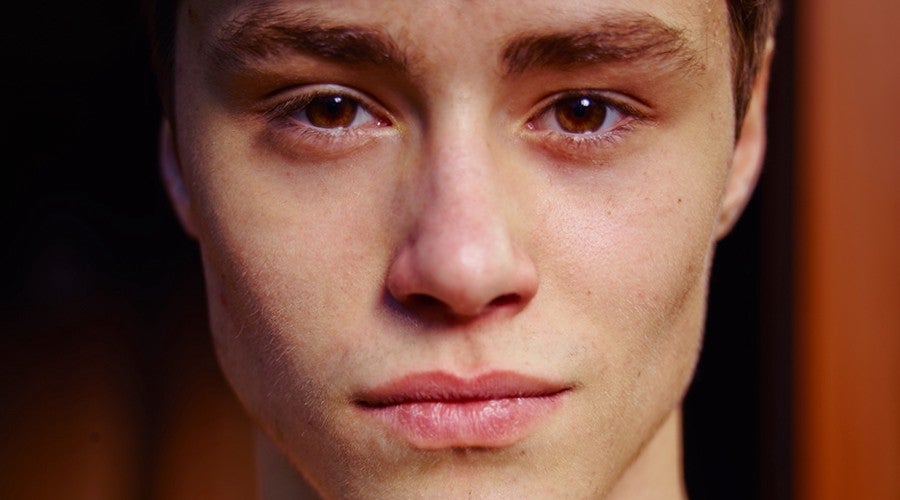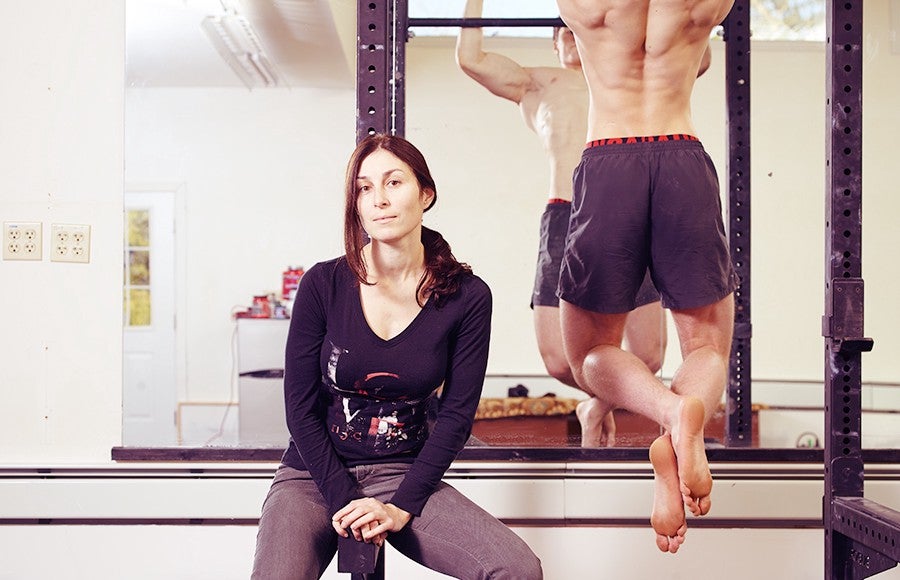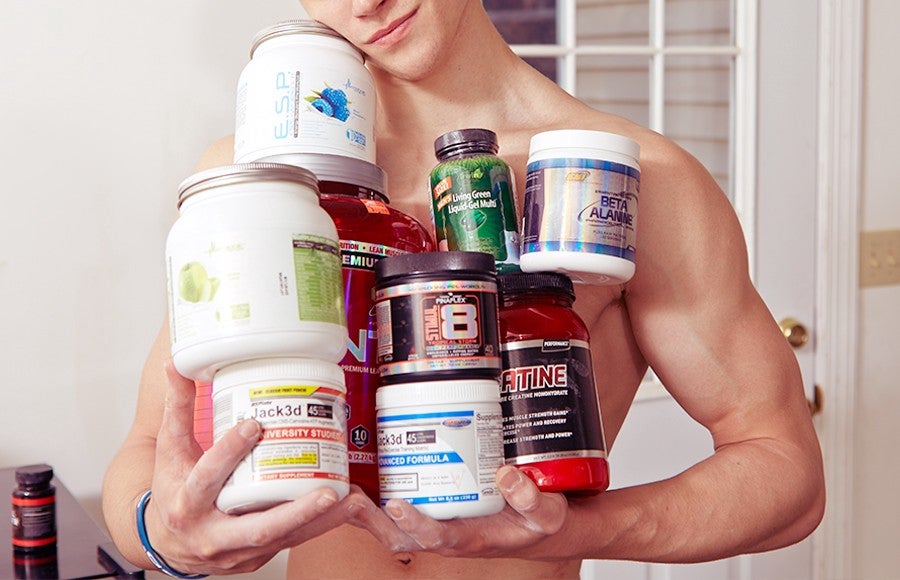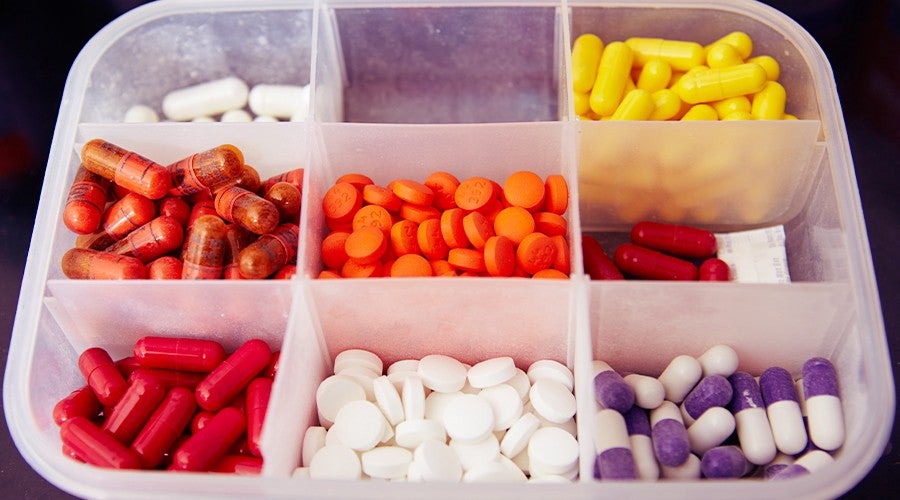The YouTube video opens with a photo of a 14-year-old boy, painfully thin — 5 feet 7 inches, 98 pounds.
His ribs and collarbones protrude. His head of dirty-blond hair, swept to one side, looks too big for his neck. His mouth is agape, as if he’d been caught off guard; his body is blurred, mid-motion, as if he’s not quite sure he wants to stand still long enough to see the final result of his own selfie.
The video slide show, set to electronic music, is called “David Laid 3 Year Natural Transformation 14–17.” As it proceeds, it chronicles the early years of his life. He’s at the beach in his hometown of Atlantic City. He’s at summer camp in rural Pennsylvania. He’s on a skateboard — a pale kid whose hockey coach calls him “chicken legs.” This is David Laid before.

And then, starting at the one-minute mark of the five-minute video, a new class of photos emerge — an exhaustive series of workout selfies that document his metamorphosis. As the images pass, as the skinny kid becomes bulkier and more sculpted, he looks like a Russian nesting doll being assembled in reverse.
Near the end of the video comes a crescendo of music, the reveal. This is David Laid after.
He is 6 foot 2 and 190 pounds.
In three years, he has grown seven inches and nearly doubled his weight. His body is knotted with muscle — his pecs are inflated, his cleavage monumental; his deltoids are striated, his abs segmented like an ice-cube tray.

In the last still shot of the video, Laid stares straight into the camera, issuing a challenging look, as if to say, Call me ‘chicken legs’ now.
On YouTube there are tens of thousands of videos of teens who have documented their journey from scrawny to shredded, most of them to the beat of EDM. Many boys start bodybuilding between 12 and 14. Their videos showcase similar storylines — skinny kids who hated their bodies and now want to spread the gospel of bodybuilding and personal change. They post vlogs of their workouts and diets. They flex new muscles on Instagram and Snapchat. They message one another on social media and meet up to pump iron and share tips.
To the legion of skinny boys who find his videos online, Laid’s story is both an inspiration and a roadmap. Since uploading his transformation video to YouTube in August, Laid has racked up 5 million views. He has more than 23,400 Instagram followers and 54,000 YouTube subscribers. His pop-star good looks don’t hurt either. With his fair skin, button nose, high cheekbones, dark eyebrows and mischievous smile, Laid looks like a super-ripped Bieber.
Laid was born in Estonia when his mother Nino, who had moved there from Russia, was 23. When Laid was two, his father died in a fall from a cruise ship that was docked at harbor. A few years later, mother and son immigrated to the U.S. and Nino bought a café.
Like many kids going through puberty, Laid was unhappy with his skinny body. He remembers being the lightest player on his hockey team. He was teased in the locker room and he hated wearing a bathing suit — which is tough to avoid when you live near the beach.
It didn’t help his self-confidence, he says, that he grew up without a father.
At 14 Laid was diagnosed with scoliosis, after which he started doing some weight training with a physical therapist. Still, the skinny jokes continued. Fed up, Laid searched YouTube for ways to get bigger, which is how he came across the transformation videos that motivated him to begin his own metamorphosis.
At first, Laid was so thin his progress was rapid and easy to chart. Kids at school took notice. “When you start working out and the compliments begin to pour in, it pushes you even harder,” Laid says.
He quit hockey — and also quit doing most chores around the house, according to Nino — so he could use every spare minute to train. “It was weird, but I knew this was what I was going to do for the rest of my life,” Laid says.

The 14-year-old constructed a strict regimen for himself. “I would watch YouTube fitness videos, eat, go to the gym, go home, watch more videos, go to bed, repeat. That’s all I would do. That and go to school.”
His icons were fitness models who documented their workouts and lifestyles through vlogs. Marc Fitt, 23, is a square-jawed, upbeat French Canadian whose behind-the-scene videos showcase his morning routine and bed head. Keith and Kevin Hodge, who go by the “Hodge twins,” are beefy, foul-mouthed dudes with identical crewcuts. They often film themselves eating obscene amounts of food. Jeff Seid, a 21-year-old who likes to say “bro” and “fuck,” makes videos that range from slick compilations of his beach workouts to candid Q&A sessions in his bedroom. Laid calls them his “man crushes.”
“I would watch YouTube fitness videos, eat, go to the gym, go home, watch more videos, go to bed, repeat. That’s all I would do. That and go to school.”
Since he posted his transformation videos — the first documenting his 18-month transformation in December 2013; the second, the extended three-year version in August 2015 — Laid himself has become a role model. The comment sections of his Instagram and YouTube accounts are filled with kids’ compliments and desperate yearnings. “Hey man I would love to talk to u I’ve seen your body transformation a million times” writes Peruvianwhiteboi, concluding, “please respond bro.”
Under Laid’s video titled “Bench Press Tips,” another commenter asks for more specific advice: “When I’m doing the leg drive, my lower back hurts a little. Am I doing it wrong? Or its normal?”
“It’s surreal,” Laid says, reflecting on his newly acquired public persona. “It’s still hard for me to comprehend people actually care enough to watch my videos.”
On a sunny afternoon in Atlantic City, Laid sits at a table outside his mom’s small diner on a quiet street, away from the flashy casino signs of the main strip.
At lunch with him today is his workout buddy, Qwin Vitale. The two started to hang out two years ago after they met at Mainland Regional High School, when Laid was still a sophomore and Vitale, now 19, was a jacked senior football player. Now they train, eat and make workout videos together. With the money Laid has made from the ads on his video, he recently bought a Digital SLR camera to improve the quality of his posts.
Laid orders a tall stack of blueberry banana pancakes. He pays a lot of attention to his diet and has made a few YouTube videos about what he eats — usually big plates of breakfast food, chicken sandwiches in hot dog buns, and vats of pasta. He wants his fans to know that in addition to basic nutrients, they need to eat a ton of calories to put on muscle, no matter how unhealthy the food might seem.
Laid’s biggest weakness as a bodybuilder is his appetite, he says. He’s never been a big eater, and as a kid, he only liked candy and regularly skipped meals. Even now, he sometimes forgets to eat. A plate of fries doesn’t tempt him — he’d rather have a fruit salad. One of his biggest regrets, he says, was “eating clean” during his first year of working out — mostly chicken, rice and veggies. On that diet, he realized after some research, he wasn’t consuming enough calories to add significant mass. Sometimes he thinks about adding heavy cream, at 50 calories an ounce, or tablespoons of olive oil, 120 calories each, to whatever he puts on his plate in order to help add to his bulk. Right now, though, he’s just focused on eating more.
“I have wet dreams about taking steroids.”
Vitale, who is 5 foot 9 and 185 pounds, doesn’t have the same appetite problems as his friend. He orders six pieces of French toast, two scrambled eggs, hashbrowns, bacon and whole-wheat toast. He calls it a “light meal.” Last night, after their workout, he went to Denny’s and downed a double cheeseburger, fries and a chocolate peanut butter milkshake (2,800 calories in all).
In their videos, Laid and Vitale drop f-bombs, give workout tips and show off their various muscle groups. In one video, “Beach Pump Up,” they work out, hit the Jersey Shore and cruise home shirtless, lords of all they survey.
It takes Laid an hour — about twice as long as Vitale — but he finally finishes his meal. Vitale gestures toward the empty plate. “Right now, I’m pretty impressed,” he says.

“I didn’t chew or taste,” Laid confesses. “I literally chopped it up and swallowed it like a pill. I didn’t even think about it. I just did it.”
Steroids (or “gear” as Laid calls them), of course, would add mass much more quickly than stacks of pancakes covered in heavy cream. But Laid vows he’s committed to growing his body in a natural way — no growth hormones or any other illegal aids — no matter how much he wants them. “I have wet dreams about taking steroids,” he says. “You have energy all the time. You feel super good. You’re stronger when you go to the gym. You’re more aggressive and confident. You have more of an alpha mentality.”
According to a study recently published in the journal JAMA Pediatrics, almost 6 percent of teenage weightlifters admit they use performance-enhancing drugs. Almost 11 percent use some other muscle-enhancing substance; one-third say they take protein powder or drink shakes to get big. Online, there are forums filled with teenage boys who want to know which steroids to use.
While body image issues have long been discussed in the context of American girls and women, the JAMA study found nearly 18 percent of American boys are “highly concerned about their weight and physique.” About half worried exclusively about gaining more muscle, while a third wished for muscle and thinness simultaneously.
Experts say it’s normal for teenage boys to want ripped bodies. And there is nothing implicitly unhealthy about young teens, even preteens, lifting weights. Experts believe these guys are better off spending too much time at the gym than engaging in other typical teenage pastimes. “Some people are hardcore partiers,” Laid says. “We’re hardcore trainers.”
Dr. Jade Stevens, a clinical psychologist who treats anxiety disorders, says the real danger is when someone focuses on their body so intensely that it interferes with regular life or causes them significant distress. If a person stops going to school, can’t hold down a job or can’t have normal relationships because he thinks his muscles aren’t big enough, he might have body dysmorphic disorder (BDD).
This unhealthy obsession with appearance affects men and women equally. Stevens says BDD often doesn’t become obvious in young people until they “leave home for college or go through a stressful or hormonal change.”
“Some people are hardcore partiers. We’re hardcore trainers.”
Some of Laid’s fitness idols led dangerous lifestyles. Greg Plitt, an extreme trainer who scaled outdoor poles and gave motivational speeches, died at 37 while filming a video on train tracks. Aziz Shavershian, a party animal who did steroids, smoked and loved showing how his new physique got him tons of beautiful women, died from a heart attack five years ago. He was 22. But Laid, who gets average grades in school, says training doesn’t consume his whole life. He can shuffle his gym schedule to attend parties, but in truth, that rarely happens. He’s dated a bit, but he’s currently single. His mom jokes that anyone who wants to date her son must join the gym.
“I’m just hoping he’s going to make right choices,” she says. “So far he’s not doing anything I would not support. I hope in the future it’s going to stay like that. I don’t want steroids to be introduced.”
After lunch, Laid pulls out his iPhone and scrolls through photos of Jon Skywalker, a 21-year-old sponsored fitness model with 186,000 Instagram followers. “Wow, I’m having one of those moments where I’m looking at his pics and just want to go on gear so bad,” he groans.
Over the past year, Laid has decided he wants to monetize his physique and become a professional fitness model. Sponsored by clothing brands and supplement companies, fitness models compete in physique contests; the real money comes through the coaching tips, personalized workouts and nutrition plans the model can generate from online sales.

To boost his profile within in the community, Laid will have to compete with guys like Skywalker. Known as much for being a badass as for his carved physique — he frequently posts photos of himself partying, smoking and posing with his lingerie-clad girlfriend — Skywalker is one of the fitness industry’s superstars. He has openly given advice about using anabolic steroids on internet forums.
While Laid doesn’t juice, supplements are another story. He reaches into his gym bag and pulls out a big plastic container with nine separate compartments, each filled with brightly colored pills. In addition to using typical powder supplements, like Jack3d, Ripped Freak and Hyper FX, Laid and Vitale down a collection of other substances before they hit the gym.
There is caffeine for energy; ibuprofen to avoid workout pain or soreness. OxyLean and Full Power are stimulants that contain 1–3 Dimethylamylamine (DMAA), which is banned in at least seven countries, including Canada, the U.K. and Australia. The World Anti-Doping Agency banned the drug in 2010. In the U.S., despite FDA warnings, DMAA is still sold in some nutrition and supplement stores. The effects of DMAA are stronger than caffeine, similar to those seen with Adderall or Ritalin. Use of DMAA increases blood pressure and has been linked with strokes, heart attacks, psychiatric disorders and death.

Laid swallows two DMAA pills; Vitale opts for Yellow Bullet, a diet pill with intense stimulants. They each mix supplement powder into their water. Despite the controversy, Laid says DMAA is his favorite pre-workout stimulant. “A lot of people recommend teenagers don’t take this stuff, but we’re kind of different,” Laid says. “This is kind of like our life, and we want to become something most teens don’t.”
Laid and Vitale walk into Island Gym and greet a few guys they know on their way to the weight pit. Laid picks up a 45-pound barbell. “It feels like a toothpick,” he says, proceeding to rack it with weight plates.
Located in a strip mall 20 minutes outside of Atlantic City, the gym has yellow equipment, a palm-tree mural and purple-and-orange walls — a taste of the tropics in suburban New Jersey. It’s late on a Saturday afternoon and most of the machines are empty, but the free weights area is filled with nearly a dozen brawny lifters — one with traps so huge they swallow his entire neck, another with a neon-yellow tank top that says “Gym Shark.” Vitale estimates that 40 percent of the regulars at his gym take steroids.
Today, since I’m watching, Laid and Vitale both have vowed to set personal records — a 585-pound dead-lift for Laid; a 470-pound squat for Vitale.
Laid does a few practice lifts, working his way up to 495 pounds, 65 pounds beneath his personal best. He approaches the bar and checks his feet, which are in a “sumo” position (i.e., much farther apart than shoulder width). Knees bent, back straight, he settles on a grip. He gulps a breath of air and yanks upward.
The weight doesn’t budge. It seems as if someone has bolted it to the floor.
“What the fuck?” Laid says, looking up with an expression of equal parts outrage and bewilderment.
He tries again.
Nothing.
In his mind, Laid goes through a systems check, trying to figure out why the hell he can’t even get close to his personal record, much less his projected new one. Maybe his stance is off? Maybe the nagging hip pain he’s been experiencing is somehow to blame? Maybe it’s his shitty appetite?
“I’m going to call my trainer and tell him I want to kill myself,” he says.
He’s kidding. Sort of.
In the locker room, in front of the mirror, Laid and Vitale roll up their shorts, take off their shirts and begin to cycle through a series of poses. Three hours after the beginning of a rigorous workout, all thoughts of deadlift failure have been forgotten. Their abs are chiseled; their thighs are carved like boulders; their arms and shoulders resemble four-wheel drive tires.

In short order, cell phones come out for new selfies Laid plans to share with his adoring masses. Looking back, Laid says, weightlifting has pretty much been the best thing ever to happen to him. It’s given him a purpose, respect from his peers, even a professional future.
“When I started training,” he says, “everyone made fun of me.”
“They said ‘You’re so skinny.’ They don’t do that anymore.”
Compared to most teens, he is incredibly ripped. Now scrawny kids want to be him. His mom’s friends jokingly ask whether he has a girlfriend. He no longer has a problem being shirtless on the beach.
But Laid still can be his own worst enemy. Sometimes when he looks in the mirror, he still sees that wisp of a boy who wants to be a warrior.
Outside the gym, he thinks about the big meal he needs to devour. Maybe pasta with chopped Bratwurst or his mom’s leftovers.
“I’m going to find a way to eat 10,000 calories and I’m going to weigh 320 pounds,” he jokes. “There’s zero chance of that. No matter what drugs I take I can’t get there.”
